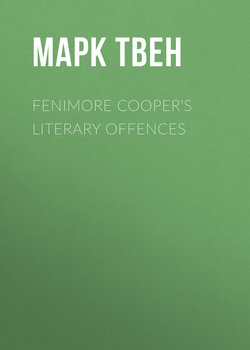
000
ОтложитьЧитал
Cooper made the exit of that stream fifty feet wide, in the first place, for no particular reason; in the second place, he narrowed it to less than twenty to accommodate some Indians. He bends a “sapling” to the form of an arch over this narrow passage, and conceals six Indians in its foliage. They are “laying” for a settler’s scow or ark which is coming up the stream on its way to the lake; it is being hauled against the stiff current by a rope whose stationary end is anchored in the lake; its rate of progress cannot be more than a mile an hour. Cooper describes the ark, but pretty obscurely. In the matter of dimensions “it was little more than a modern canal-boat.” Let us guess, then, that it was about one hundred and forty feet long. It was of “greater breadth than common.” Let us guess, then, that it was about sixteen feet wide. This leviathan had been prowling down bends which were but a third as long as itself, and scraping between banks where it had only two feet of space to spare on each side. We cannot too much admire this miracle. A low-roofed log dwelling occupies “two-thirds of the ark’s length”—a dwelling ninety feet long and sixteen feet wide, let us say a kind of vestibule train. The dwelling has two rooms—each forty-five feet long and sixteen feet wide, let us guess. One of them is the bedroom of the Hutter girls, Judith and Hetty; the other is the parlor in the daytime, at night it is papa’s bedchamber. The ark is arriving at the stream’s exit now, whose width has been reduced to less than twenty feet to accommodate the Indians—say to eighteen. There is a foot to spare on each side of the boat. Did the Indians notice that there was going to be a tight squeeze there? Did they notice that they could make money by climbing down out of that arched sapling and just stepping aboard when the ark scraped by? No, other Indians would have noticed these things, but Cooper’s Indians never notice anything. Cooper thinks they are marvelous creatures for noticing, but he was almost always in error about his Indians. There was seldom a sane one among them.
The ark is one hundred and forty feet long; the dwelling is ninety feet long. The idea of the Indians is to drop softly and secretly from the arched sapling to the dwelling as the ark creeps along under it at the rate of a mile an hour, and butcher the family. It will take the ark a minute and a half to pass under. It will take the ninety foot dwelling a minute to pass under. Now, then, what did the six Indians do? It would take you thirty years to guess, and even then you would have to give it up, I believe. Therefore, I will tell you what the Indians did. Their chief, a person of quite extraordinary intellect for a Cooper Indian, warily watched the canal-boat as it squeezed along under him, and when he had got his calculations fined down to exactly the right shade, as he judged, he let go and dropped. And missed the house! That is actually what he did. He missed the house, and landed in the stern of the scow. It was not much of a fall, yet it knocked him silly. He lay there unconscious. If the house had been ninety-seven feet long he would have made the trip. The fault was Cooper’s, not his. The error lay in the construction of the house. Cooper was no architect.
There still remained in the roost five Indians.
The boat has passed under and is now out of their reach. Let me explain what the five did—you would not be able to reason it out for yourself. No. 1 jumped for the boat, but fell in the water astern of it. Then No. 2 jumped for the boat, but fell in the water still farther astern of it. Then No. 3 jumped for the boat, and fell a good way astern of it. Then No. 4 jumped for the boat, and fell in the water away astern. Then even No. 5 made a jump for the boat—for he was a Cooper Indian. In the matter of intellect, the difference between a Cooper Indian and the Indian that stands in front of the cigarshop is not spacious. The scow episode is really a sublime burst of invention; but it does not thrill, because the inaccuracy of the details throws a sort of air of fictitiousness and general improbability over it. This comes of Cooper’s inadequacy as an observer.
The reader will find some examples of Cooper’s high talent for inaccurate observation in the account of the shooting-match in The Pathfinder.
“A common wrought nail was driven lightly into the target, its head having been first touched with paint.”
The color of the paint is not stated—an important omission, but Cooper deals freely in important omissions. No, after all, it was not an important omission; for this nail-head is a hundred yards from the marksmen, and could not be seen by them at that distance, no matter what its color might be.
How far can the best eyes see a common house-fly? A hundred yards? It is quite impossible. Very well; eyes that cannot see a house-fly that is a hundred yards away cannot see an ordinary nailhead at that distance, for the size of the two objects is the same. It takes a keen eye to see a fly or a nailhead at fifty yards—one hundred and fifty feet. Can the reader do it?



